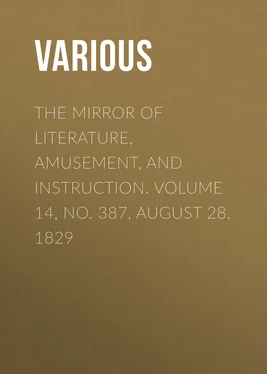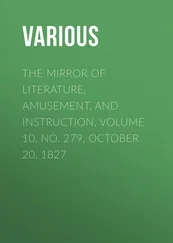Various - The Mirror of Literature, Amusement, and Instruction. Volume 14, No. 387, August 28, 1829
Здесь есть возможность читать онлайн «Various - The Mirror of Literature, Amusement, and Instruction. Volume 14, No. 387, August 28, 1829» — ознакомительный отрывок электронной книги совершенно бесплатно, а после прочтения отрывка купить полную версию. В некоторых случаях можно слушать аудио, скачать через торрент в формате fb2 и присутствует краткое содержание. Жанр: foreign_antique, periodic, Развлечения, foreign_edu, на английском языке. Описание произведения, (предисловие) а так же отзывы посетителей доступны на портале библиотеки ЛибКат.
- Название:The Mirror of Literature, Amusement, and Instruction. Volume 14, No. 387, August 28, 1829
- Автор:
- Жанр:
- Год:неизвестен
- ISBN:нет данных
- Рейтинг книги:5 / 5. Голосов: 1
-
Избранное:Добавить в избранное
- Отзывы:
-
Ваша оценка:
- 100
- 1
- 2
- 3
- 4
- 5
The Mirror of Literature, Amusement, and Instruction. Volume 14, No. 387, August 28, 1829: краткое содержание, описание и аннотация
Предлагаем к чтению аннотацию, описание, краткое содержание или предисловие (зависит от того, что написал сам автор книги «The Mirror of Literature, Amusement, and Instruction. Volume 14, No. 387, August 28, 1829»). Если вы не нашли необходимую информацию о книге — напишите в комментариях, мы постараемся отыскать её.
The Mirror of Literature, Amusement, and Instruction. Volume 14, No. 387, August 28, 1829 — читать онлайн ознакомительный отрывок
Ниже представлен текст книги, разбитый по страницам. Система сохранения места последней прочитанной страницы, позволяет с удобством читать онлайн бесплатно книгу «The Mirror of Literature, Amusement, and Instruction. Volume 14, No. 387, August 28, 1829», без необходимости каждый раз заново искать на чём Вы остановились. Поставьте закладку, и сможете в любой момент перейти на страницу, на которой закончили чтение.
Интервал:
Закладка:
Various
The Mirror of Literature, Amusement, and Instruction / Volume 14, No. 387, August 28, 1829
CONSTANTINOPLE

CONSTANTINOPLE
"Queen of the Morn! Sultana of the East!"
The splendour and extent of Constantinople are not within the compass of one of our pages; but the annexed Engraving furnishes some idea of a section of this queen of cities. It extends from Seraglio Point to the Janissaries' Tower, and though commanding only a portion of the city, includes the domes of the magnificent mosques of Santa Sophia and the Sultan Achmet, which rise from a vast assemblage of towers, palaces, minarets, &c. in every style of architecture.
We have so often and so recently touched upon the ancient and modern state of Constantinople, that we fear a recapitulation of its splendour would be uninviting to our readers. 1 1 See "Sailing round Constantinople," MIRROR, vol. x. p. 278. Engraving and Description of the Castle of the Seven Towers, ibid, vol. x. p. 361. Extent of Constantinople, vol. xi. p. 298. Lines on Constantinople, vol. xii. p. 58. Taking of the City by the Turks, vol. xii. p. 274.
Nevertheless, as its mention is so frequently coupled with the seat of war, and the "expulsion of the Turks from Europe," our illustration will at this period be interesting, as well as in some measure, explanatory of the position of the city, which is so advantageous as to make it appear fit for the seat of dominion over the whole world. Can we then be surprised at its forming so tempting a lure to surrounding nations?
The city stands at the eastern extremity of Romania, on a neck of land that advances towards Natolia; on the south it is washed by the sea of Marmora, and on the north-east by the gulf of the Golden Horn. It is built, like ancient Rome, on seven hills, rising one above the other in beautiful succession, and sloping gently towards the water; the whole forming an irregular triangle, about twelve miles in circumference, the entire of which space is closely covered with palaces, mosques, baths, fountains, and houses; at a short distance the proudly swelling domes of 300 mosques, the tall and elegant minarets, crowned by glittering crescents, the ancient towers on the walls, and the gaudily coloured kiosks and houses rising above the stupendous trees in the seraglio, situated on the extreme point, form a rich, picturesque, and extraordinary scene. The gulf of the Golden Horn, to the north-east of the city, forms a noble and capacious harbour, four miles in length, by half a mile in breadth, capable of securely containing 1,200 ships of the largest size, and is generally filled with the curiously built vessels and gaily decorated boats of the Turks; on the opposite shore is the maritime town of Galata, containing the docks, arsenals, cannon founderies, barracks, &c.; above which stands the populous suburb of Pera, the residence of the foreign ministers of the Porte, and all foreigners of distinction, none whatever being allowed to reside in the city. Beyond, as far as the eye can reach, is an immense forest of cypress and mulberry trees, being the extensive cemeteries of all persuasions. From Galata, the European shore of the Bosphorus forms one continued line of towns; palaces in every style of architecture, pleasure gardens, and romantic villages. On the opposite, or Asiatic shore, stands the extensive town of Scutari, also a suburb of Constantinople, although in another quarter of the globe, and separated by a sea a mile in breadth; and at a short distance is the ancient and ruinous city of Calcedone. The group of the Prince's Islands, in the Sea of Marmora, and the snow-clad summit of Mount Olympus, close the prospect. Such is a mere outline of the natural and artificial beauty of Constantinople.
The city itself is surrounded by walls, built of freestone, with alternate layers of Roman brick, flanked by 478 towers; the walls, however, are in several places so dilapidated as to be incapable of any defence without great reparation. On the land side, the fortifications consist of a triple wall, with towers at every 150 yards; the first wall being 30 feet in height; the second 20, and about 30 feet from the first; the third is twelve feet in height; beyond this is a fosse, thirty feet wide, now converted into gardens, and filled with fine grown trees, and a low counterscarp. There are five gates on this side, and several to the water. The streets, of which there are 3,770, with the exception of two or three, are narrow, irregular, badly paved, and exceedingly dirty, the only scavengers being vultures and half-starved dogs. There are fourteen imperial mosques, about 200 others, and above that number of messjids or chapels. The number of houses is prodigious; in 1796, the register of Effendissy gave 88,185 within the walls; they are mostly constructed of wood, and the dwellings of the lower classes are mere wooden boxes, cool in summer, the windows being unglazed, and in winter heated by pans of charcoal. Fires are consequently very frequent. The khans, or warehouses of the merchants are, however, fireproof; the bazaars are also defended from fire, and are well built; and coffeehouses very numerous. The city is amply supplied with water, there being 730 public baths, a superb fountain in the Chinese taste in every street, and few houses without similar provision. The population of the city and suburbs is estimated at upwards of 600,000; of these above one half are Turks, the remainder Jews, Franks, Greeks, &c.
We have only space to particularize a few of the most prominent buildings in our view. To the left is the Seraglio Point, or superb palace of the Sultan, whose treasures almost realize the fables of romance. Next is the superb dome of the Mosque of the Sultan Achmet, without exception the finest building ever raised by the Turks. It is surrounded by a lofty colonnade of marble, of various colours, surmounted by 30 small domes: the large dome is supported by four gigantic piers, covered as well as most of the interior, with fresco paintings; it is rich in columns of verd antique, Egyptian granite, and white marble; there are also four smaller domes, similarly ornamented. Next, near the centre of the Engraving is the Mosque of Santa Sophia, a truly superb and perfect monument of antiquity, built at an expense of 320,000 pounds of silver, (some authors say gold. 2 2 For an Engraving and full description of the Mosque of Santa Sophia, see the MIRROR, vol. ii. p.p. 473, 486.
) Next in importance are the Mosques of the Sultans Osmyn, Bajazet, and Selim; and the Gulf of the Golden Horn, or the Harbour.
Among the suburbs of Constantinople, Scutari is not the least interesting, inasmuch as it leads us to notice the funereal customs of the Turks, and their cemeteries, of which Scutari is the principal site.
Interment almost immediately follows upon the decease of the person; a practice common to all classes at Constantinople. The corpse is carried to the grave on a bier by the friends of the deceased: this is considered as a religious duty, it being declared in the Koran, that he who carries a dead body the space of forty paces, procures for himself the expiation of a great sin. 3 3 Mr. Hobhouse has pointed out some remarkable points of similarity between the funereal customs of the Greeks and those of the Irish; in particular, the howling lament, the interrogating the corpse, "Why did you die?" and the wake and feast. "But a more singular resemblance," he adds, "is that which is to be remarked between a Mahommedan and an Irish opinion relative to the same ceremony. When a dead Mussulman is carried on his plank towards the cemetery, the devout Turk runs from his house as the procession passes his door, for a short distance relieves one of the bearers of the body, and then gives up his place to another, who hastens to perform the same charitable and holy office. No one who has been in Ireland, but must have seen the peasants leave their cottages or their work, to give a temporary assistance to those employed in bearing the dead to the grave an exertion by which they approach so many steps nearer to Paradise."
Интервал:
Закладка:
Похожие книги на «The Mirror of Literature, Amusement, and Instruction. Volume 14, No. 387, August 28, 1829»
Представляем Вашему вниманию похожие книги на «The Mirror of Literature, Amusement, and Instruction. Volume 14, No. 387, August 28, 1829» списком для выбора. Мы отобрали схожую по названию и смыслу литературу в надежде предоставить читателям больше вариантов отыскать новые, интересные, ещё непрочитанные произведения.
Обсуждение, отзывы о книге «The Mirror of Literature, Amusement, and Instruction. Volume 14, No. 387, August 28, 1829» и просто собственные мнения читателей. Оставьте ваши комментарии, напишите, что Вы думаете о произведении, его смысле или главных героях. Укажите что конкретно понравилось, а что нет, и почему Вы так считаете.












